Westville, Illinois
In the early 20th century Westville was a coal mining town. The majority of its population of 2500 were ethnic Lithuanians according to some sources. After the mines were closed, many of them left to Chicago. However, Lithuanians make up 4,7% of the local population of 3000 even today.
The most Lithuanian site in the city is undoubtedly the Lithuanian National Cemetery (est. 1909). There, on many graves, you could still find long Lithuanian inscriptions from more than a century ago. The cemetery is especially Lithuanian with three Lithuanian flags waving.
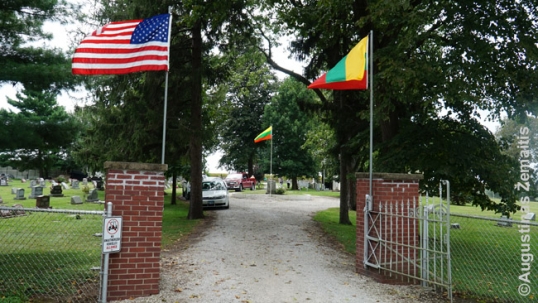
One of the entrances to the Westville Lithuanian cemetery
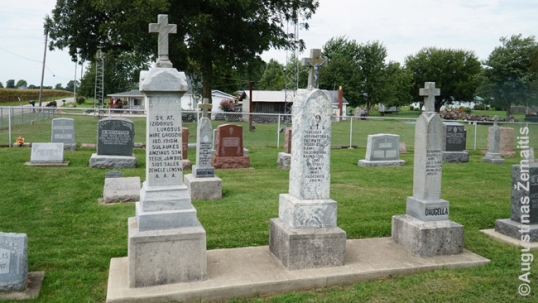
Some of the oldest graves at the Westvillle Lithuanian Cemetery
The cemetery office has originally served as a coal mine building before being moved there. ~5 people are still buried there every year while some 1000 are buried in total.
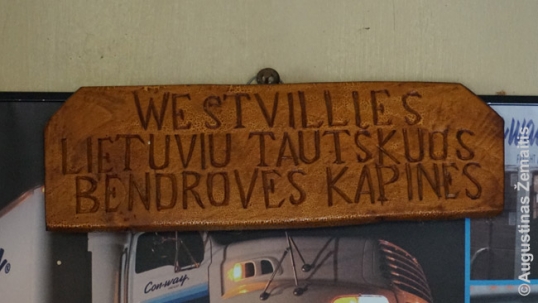
Sign at the Westville Lithuanian Cemetery office
There are several memorials in the cemetery. The non-Lithuanian World War 2 veterans memorial has been built in 2008, while a small 2002 memorial is dedicated to Mike Laitas, a 30-years-long volunteer who kept the cemetery. As such cemeteries receive no government support, they depend on such volunteers to continue their existence.
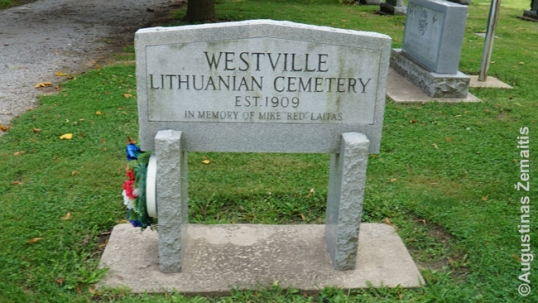
Mike Laitas memorial at the Westville Lithuanian cemetery
The Memorial to the Holy Cross church reminds of the church that was established in 1914 in a bought-out Presbyterian building. This church was established by the same people who earlier established the Lithuanian cemetery of Westville. The church did not recognize the authority of the Pope: instead, the parishioners would apply for priests at various Old Catholic communions (Old Catholics were Catholic priests who left Catholicism due to disagreement with papal actions). The reason to establish both cemetery and the church was in the conflicts with the local Catholic priests who were said to request fixed donations and not to permit certain people from being buried in the Catholic cemetery.
Holy Cross Lithuanian church has been closed in 1960 but its history still lingers. The memorial to it has been constructed in 2004 as the caretakers of the cemetery brought in the church bell they discovered somewhere as well as the cornerstone of the church.

Memorial for the Lithuanian National Catholic church at the Westville Lithuanian Cemetery
One of the most famous leaders of the Holy Cross church was priest Pranas Mikalauskas (1889-1933), buried in a heart-shaped lot in the middle of the cemetery. His "fame" came from his death which was possibly either a murder or a suicide. If it was murder it was unclear by whom and possible suspects have included mysterious men from Chicago, his own estranged congregation or Roman Catholics. A short book has been published on the Lithuanian interreligious conflicts of the era: "A Short History of a Big Lithuanian Row in Westville, Illinois". While Mikalauskas's death was ruled suicide by the authorities of the time, the claims that he was murdered were widely spread by his successor priest Vipartas, who also claimed he was threatened himself and pointed at the Catholics. It was Vipartas who built the heart-shaped memorial for Mikalauskas and who continued to be the face of his parish until his death, after which the Holy Cross parish closed.
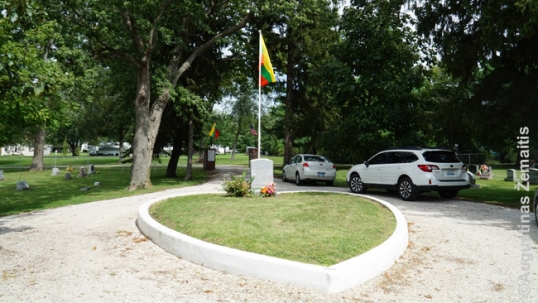
Priest Mikalauskas grave

Priest Mikalauskas grave (close-up)
On the original site of the Holy Cross Lithuanian church, a residential home now stands, with only the former pathway reminding that a church used to stand there.

Still-remaining stone path that used to lead to the now-demolished Lithuanian National Catholic church of Westville
The main adversary of the National Catholic church in the battle for Lithuanian souls was the Roman Catholic church of Ss. Peter and Paul, established in 1897 (therefore, one of the oldest Lithuanian churches in the USA). It has been also since closed (in 1989) and demolished, leaving an empty lot.
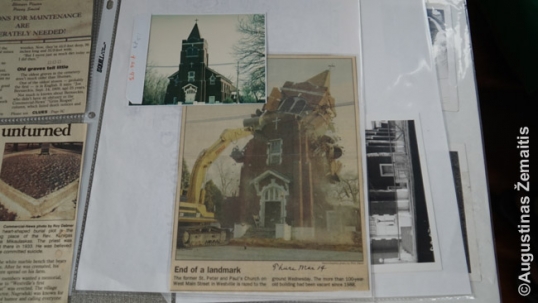
Lithuanian Ss. Peter and Paul church during demolition
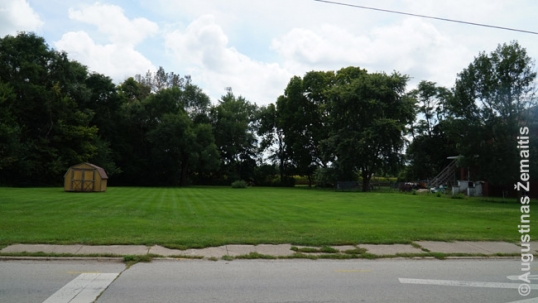
Site of the Ss. Peter and Paul Lithuanian church
Lithuanian Roman Catholics also had their own Ss. Peter and Paul cemetery (est. 1904). The cornerstone of the church has been located there, near the center, close to the burial place of priest Paukstis, pastor of the church for many decades and a rival of Vipartas. Some of the statues that used to stand in the churchyard have been relocated to the north of the cemetery but they lack Lithuanian details. In general, that cemetery looks much less Lithuanian than the other one, although it has many Lithuanians buried there as well.

Graves at the Westville Ss. Peter and Paul Lithuanian Cemetery

Cornerstone of the Ss. Peter and Paul Lithuanian church
Westville is said by the locals to have been included in the Guinness World of Records for the vast number of its per-capita bars and pubs. Numerous of these pubs were operated by Lithuanians.
The Depot museum at Central Westville has a few Lithuanian-related materials. It generally hosts memorabilia of the town.
The map
All the Lithuanian locations, described in this article, are marked on this interactive map, made by the "Destination Lithuanian America" expedition (click the link):




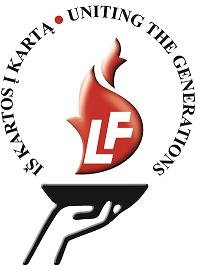

February 16th, 2016 - 21:12
I happened to find this article at the Fort Wayne, IN library, one of the best places in the US for genealogy. It was from the Fort Wayne News, Tues. Eve., April 12, 1904, page 5, column 1. There’s a good chance that he’s buried at Sts. Peter & Paul at Westville IL, unless he was returned to Lithuania…? Doesn’t appear in FindAGrave.
—————————————————————-
MYSTERY AROUND THE DEATH OF BOY
MAY HAVE BEEN MURDERED ON AN EMIGRANT TRAIN.
FOUND DEAD ALONG TRACK
Mystery surrounds the death of John Fanuszus, the Russian boy, aged nineteen years, found dead last week along the Wabash railroad between Fort Wayne and Peru, mention of which was made in the News. He was in company with a car load of emigrants, which passed through this city on Wabash passenger train No. 7. William Snyder, a brakeman on a freight train, discovered the body of Fanuszus beside the track. The Russian’s head was found buried four inches deep in the mud and the back of his head was broken open. The car load of emigrants was attached to the rear of the train, and, so far as can be learned, none of the train crew saw the boy fall off.
Where the body was found there is straight track for three miles, so the movements of the train are not supposed to have thrown Fanuszus off. While the emigrants were at the station here some of them seemed to be angry, and this, together with the fact that none of the foreigners have inquired about the welfare of their countryman, leads some to believe that Fanuszus was struck in the head with some blunt instrument and then thrown from the train. The coroner is of the opinion that death was instantaneous. Fanuszus had a ticket to Westville, Ill., and in his pocket was found the card of Petras Tanuses, at Westville, Ill. The body is being held until Tanuses is heard from. {end}
February 16th, 2016 - 23:16
Return of the body to Lithuania was I think very unlikely in those times. Very costly and hard to organize for relatives in Lithuania who were likely illiterate peasants.
Also at those times it was generally considered that if a person goes to the USA it is for life or at least for decades. It was usually impossible for most emigrants even to visit homeland, as that would have required a ship journey – both costly and extremely time consuming (it would have been possibe only after getting out of job rather than on holiday). It was much different from today when we have relatively affordable and quick jet planes.
I am not sure where he was buried, it may be yet another plausible option that he is buried somewhere near Fort Wayne where his body was found.
September 2nd, 2017 - 04:15
I AT ABOUT 1980 VISITED HARTHORNE OKLAHOMA,WHICH AFTER MEETING SPEAKER OF THE US HOUSE OF REP. STATING THAT MANEY LITHUANIAN- AMERICANS LIVED I S/EAST OKLA .AND THAT A RANCHER OF LITHUANIAN HERITAGE WAS JUST IN HIS OFFICE ; CARL ALBERT SUPPORTED ALL THINGS ABOUT LITHUANIA.I VISITED HARTSHORNE AND MEAT THE MAYER MR SMITH WHO WAS LITH-AMER. WHO TOK ME TO THE CHATOLIC CEMETERY WHERE 1/3 OF THE GRAVE STONES HAD LITHUANIAN NAMES ,WITH ITALIAN COAL MINER GRAVES, I LEFT TWO BOOKS ON LITUANIA AND VYTAUTAS THE GREAT AT THE LOCAL LIBERY;THE MAYER TOLD ME OVER 200M MLITHUANIAN COAL MINERS WORKED AT THE CHOUNIE COAL MINES WHICH LITH WHERE I MAJORITY; I HOPE OUR YOUNGER LIT6H-AMER HISTORIANS WILL VISIT THIS REGION AND WRITE ABOU THIS HERITAGE IN OKLAHOMA !!!
February 27th, 2019 - 19:35
I’ve been working on my genealogy and found sooo many relatives in Westville. However, I lived in Oklahoma for 10+ years and never knew any Lithuanians there. Next time I go back I will definitely make a visit to Hartshorne! Thanks for all the info.
November 2nd, 2021 - 20:36
Hi. My accordion teacher in Westville was young Appanaitis woman. Can’t recall her given name, however.
November 1st, 2023 - 16:08
My sister Julia or I might be able to help with that if you gave us the year/s of your classes.
January 14th, 2024 - 21:18
I’d say it was mid 50s for the classes. When she eventually went to the University of Illinois, I went there once a week for classes with her. I think her father’s name was “Algie” (or similar).
February 3rd, 2024 - 23:02
Yep, that’s our Aunt Jerry (and Grandpa Algy*) Our sister Jacqueline
reminded me of your post.
At 87 now Jerru or Geraldind is retired and living in Chicago.She still has a piano.
*buried in Danville at the big cemetary.
February 3rd, 2024 - 23:03
Sorry for the typos.
November 18th, 2019 - 01:08
HARTSHORNE OKLAHOMA WAS ACOAL MINING TOWN AND PART OF THE CHOUNE COAL MINES; I TERNED IN INFORMATION ON THE LITHUANIAN COAL MINERS TO THE BALZAKAS LITH. MUESIUM IN CHICAGO; THE COAL COMPANY STATISTICS STATES THAT AT ONE MINE OVER 200 LITHUANIAN WORKED THERE; I VISTED THE CHATOLIC CEMETERY AND ABOUT 1/3 OF THE MARKERS HAD LITHUANIAN NAMES THE REST WHERE ITALIAN; ; I FOUND THE INFORMATION ABOUT THEM AT THE UTHA MORMAN LIBARY ABOUT THE CEMETERY ,WHILE DOING SOME DETECTIVE WORK!!!GOOD TRIP TO HARTSHORNE JULIA!!
November 2nd, 2021 - 20:33
Westville is my home town. I would say that the terms “bars“ and “pubs“ are not necessarily appropriate in describing Westville’s drinking establishments. These were “taverns” and they were well-used by the miners (including my Dad) and others.
November 1st, 2023 - 16:16
When I drive through the area of Westville, Illinois; I like to stop at this cemetrery, place a lawn chair in the midst of my family’s graves, and sit and ponder life.
I’ve also noticed many of the names of my grandparent’s school chums from their photo albums.